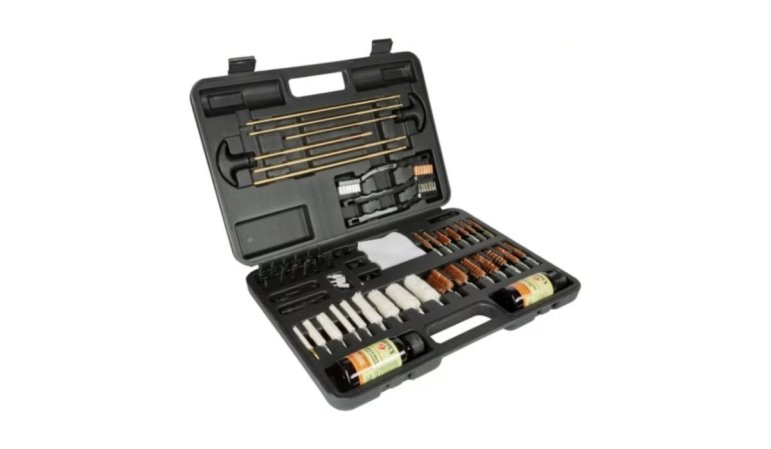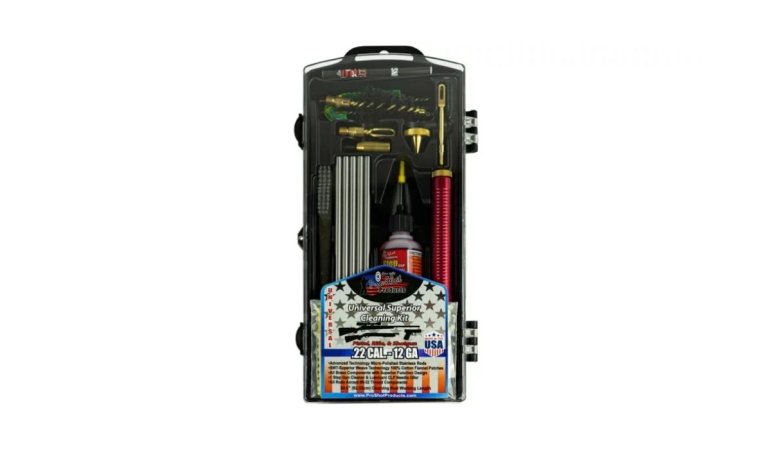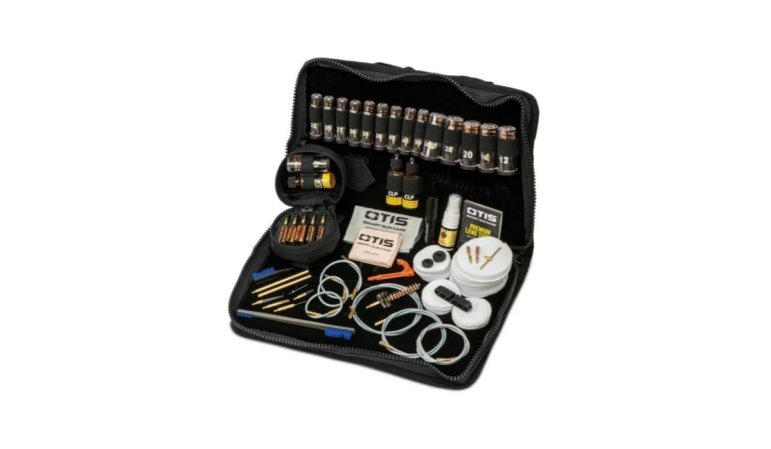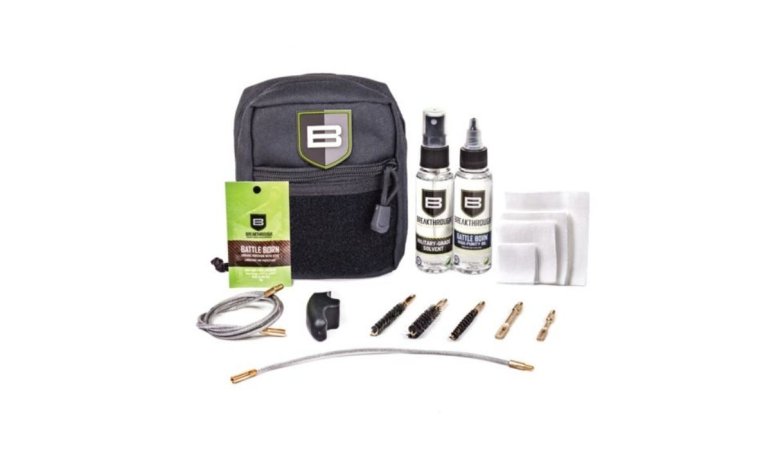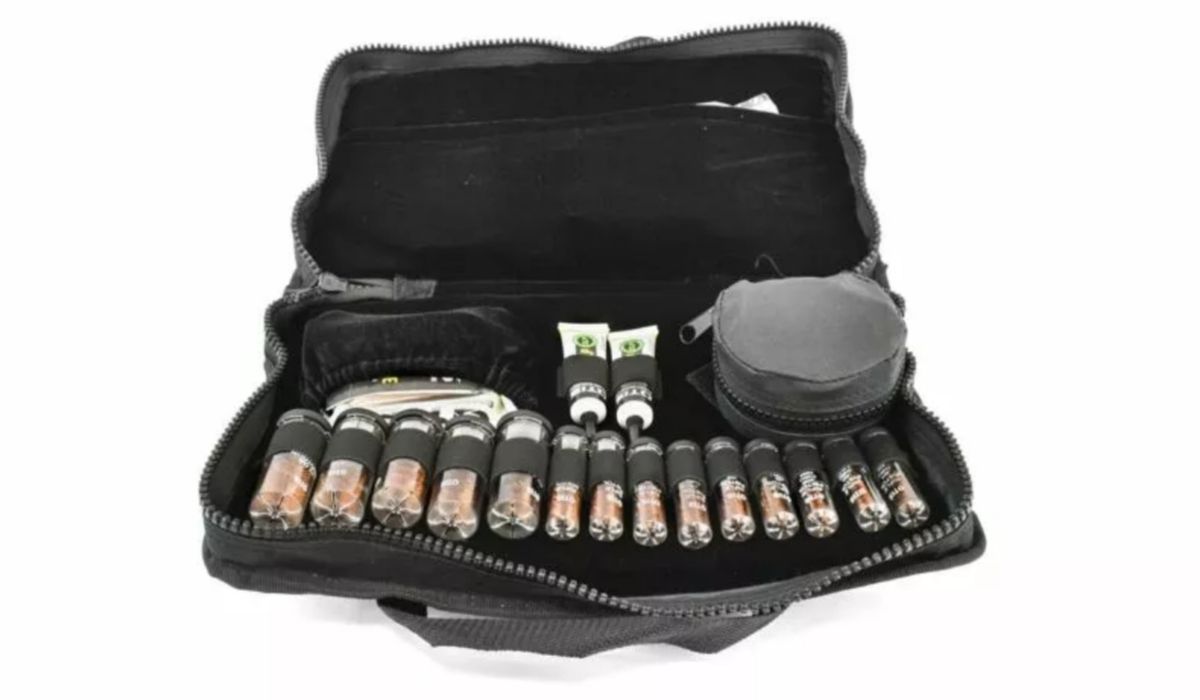

We may earn revenue from the products available on this page and participate in affiliate programs.
Whether you love it or hate it, if you shoot, you’ll have to clean your gun eventually. (Why couldn’t the Chinese have invented an explosive charge that cleans up with a quick rinse from a garden hose? Seriously, what were y’all thinking?!) Fortunately, a good gun cleaning kit can make the experience easier and maybe a little more tolerable.
Unfortunately, there are tons of different gun cleaning kits, but they all seem to have overlapping similarities. Add in the debate about which gun oil is the best on the market, and the chaos turns into the rhetorical equivalent of a nuclear meltdown. To help you navigate this (needless) minefield, we put together this guide on the best gun cleaning kits to point you in the right direction.
Best Overall
Hoppe's 9 Deluxe Cleaning Kit
Pros
- Truly universal cleaning kit
- Includes almost all the extras
- T-handle brass cleaning rod
- Convenient storage case
Cons
- Can be expensive
- No cleaning picks or firearm-specific tools
Product Specs
- Kit type: Push-through
- Storage container: Locking hard plastic case Surface
- Rust inhibitor: Lubricating oil
Best Value
Pro-Shot Universal Gun Cleaning Kit
Pros
- Affordable
- Good value
- Compact storage system
Cons
- Bore brushes use nylon bristles
- Cleaning rod lacks T-handle
Product Specs
- Kit type: Push-through
- Storage container: Hard plastic case
- Surface rust inhibitor: CLP, grease and silicone cloth
Editor’s Choice
Otis Elite Universal Gun Care System
Pros
- Truly universal cleaning kit
- Includes almost all the extras
- Includes optics cleaning components
- Top-notch warranty
Cons
- Expensive
Product Specs
- Kit type: Pull-through (cleaning cable)
- Storage container: Zippered nylon case
- Surface rust inhibitor: CLP
Best Gun Cleaning Kit for the Field
Breakthrough Clean Technologies QWIC-MIL
Pros
- Handles most common handgun and rifle calibers
- Portable, lightweight, compact
- MOLLE-compatible case
Cons
- Limited caliber range
- Bore brushes use nylon bristles
- Lacks some desirable extras
Product Specs
- Kit type: Pull-through (cleaning cable)
- Storage container: Zippered, MOLLE-compatible case
- Surface rust inhibitor: Lubricating oil
Why you should trust us
I first started pulling triggers when I was eight years old, and I received my first rifle — a Ruger 10/22 — four years later. With great power comes great responsibility, and I quickly learned that shooting a gun always requires cleaning it later. As such, I’ve been shooting and cleaning firearms for roughly two decades, and along the way, I also learned the hard way how not to clean and care for a gun.
As a writer, I’ve written about various firearms accessories, including ankle holsters and long-range scopes (my personal favorite), and other shooting-related products, such as ballistic-rated sunglasses and tourniquets. I also wrote about the differences between .308 Winchester and 7.62x51mm NATO for those of you looking to satisfy your curiosity.
In addition to relying on my own experience, I made sure to include other sources to provide you with a well-rounded perspective. In particular, I’d like to give a shout-out to 80 Percent Arms, American Gun Association, Bang-Inc.com, Brownells, CleanGunGuide.com, Guns.com, Keystone Shooting Center, NRA Family, NRA Shooting Sports USA, Otis Technology, and Warrior Poet Society for their help in completing this guide.
Types of gun cleaning kits
Gun cleaning kits come in all shapes and sizes, and shopping for one can be a bit overwhelming if you’re new to the shooting world. As a general rule, there are two main types of gun cleaning kits: push-through and pull-through. Each has its unique strengths and weaknesses, so make sure you know what you need before you (legally) take possession of a new gun cleaning kit.
Push-through
The push-through gun cleaning kits are the most traditional setup and rely on a metal (steel, aluminum, brass, etc.) or synthetic (i.e., carbon fiber) cleaning rod to move various cleaning heads up and down the barrel. Often, these rods break down into multiple pieces to make storage easier and include a patch holder and at least one bore brush. (Other cleaning heads, such as mops, chamber brushes, and cleaning jags, usually are available for individual purchase.)
These kits require the user to remove the bolt or barrel from their gun in order to run brushes and other cleaning heads from the breach to the muzzle in order to prevent fouling, dirt, and other contaminants from collecting in and around the action, trigger, and magazine well. While it is possible to run the head in the opposite direction, make sure to use a muzzle guard to preserve the accuracy and position your gun so that contaminants fall away from your gun’s internals.
Pull-through
While traditional push-through gun cleaning kits rely on a metal rod to push cleaning heads through the barrel, pull-through kits operate more like a ripcord and fall into one of two categories: cleaning cable or bore snake kits. Both operate similarly, but the devil is in the details.
Pull-through cable cleaning kits operate similarly to rod-based kits. They include a pull handle and an attachment point to accept screw-on cleaning heads. They may also include multiple screw-together cables for cleaning longer barrels, again mimicking cleaning rods.
On the other hand, bore snakes combine a thick, weighted pull cord, mop, and bore brush into a single component to streamline the cleaning process. They fit into much smaller packages than traditional cleaning kits, making them incredibly handy, although since they lack interchangeable cleaning heads, a single bore snake is limited to a single bore size.
Key features of gun cleaning kits
A gun cleaning kit is a simple, relatively straightforward affair that needs limited explanation. That said, there are still a few features worth looking for while shopping for the perfect kit to meet your needs. In addition to considering what type of kit you need, make sure to pay attention to which specific cleaning tools, liquids, and extras a particular kit includes. While you certainly can buy new or additional components later, you can save yourself a decent amount of money just by doing a little research ahead of time.
Cleaning heads
Some gun cleaning kits come with an overwhelming number of pieces that can make it difficult to understand their value. To cut through the fog, start by focusing on a kit’s selection of cleaning heads: patch holders, bore brushes, chamber brushes, mops, and jags.
By far, the most common cleaning heads are patch holders and bore brushes. These heavy lifters do the dirty work of cleaning, and in many cases, these are the only heads you’ll ever need. Most bore brushes feature bronze or brass bristles to scour away tough carbon fouling, although some brushes may use softer nylon bristles instead to eliminate scratching inside the barrel.
In some situations, however, chamber brushes, mops, and japs are worth your cash. For high-volume semi-auto shooters, chamber brushes are incredibly useful for removing carbon buildup. Both bore mops and old-school cleaning jags can speed up the cleaning process, increasing your efficiency and decreasing your gun’s downtime.
Solvents, lubricants, and rust inhibitors
Brushes and bore snakes are all well and good, but without proper solvents, lubricants, and rust inhibitors, your firearm won’t ever receive the care it needs. All good gun cleaning kits (and plenty of bad ones) include a small bottle or two of these essential liquids. Traditional kits usually include a bottle or spray can of solvent designed to strip the metal of all oil, grease, and dirt, as well as a bottle of rust and corrosion-resistant lubricating oil.
On the flip side, some gun cleaning kits come with a single bottle of CLP, which stands for “clean, lubricate, and protect.” This all-in-one solution eliminates the need for separate solvents and lubes, streamlining the cleaning process.
Some gun cleaning kits may include a silicone-impregnated cloth or two. As you wipe down your firearm with one of these cloths, it removes carbon residue, acidic finger oils, and other corrosive materials, while simultaneously laying down a thin, residue-free layer of protection against rust and corrosion. That said, these cloths do not clean or lube your weapon and are meant for quick surface cleanings.
Storage and other extras
While not technically essential, a proper storage container for your newly-acquired gun cleaning kit is absolutely worth the cash. Regardless of your preferred kit, a good storage container allows you to better organize your gear and, in some cases, make it easier to take with you to the range or into the field. Sure, you could stuff everything inside a Ziplock bag, but is it worth the hassle and frustration in order to maybe save a few pennies? I thought not.
Good gun cleaning kits come with a variety of extra components worth your money. A box of clean cotton patches and various non-bore brushes are must-have features. Other add-ons, such as a magazine well-cleaning brush and cotton swabs are also worth snapping up, especially for semi-autos like Glocks or AR-style rifles.
Benefits of gun cleaning kits
Increase reliability
Believe it or not, keeping your gun clean can actually improve its performance. Many modern firearms feature tight tolerances (i.e., gaps between parts), meaning that it takes less dirt to cause trouble faster. Dirt has a tendency to collect moisture and to wear parts down over time, so the sooner you remove it, the less harm it can do.
In the real world, dirty weapons can develop major issues, such as internal barrel pitting and failures to fire, feed, or eject. On the other hand, a dirt-free weapon will cycle more smoothly, and by taking the time to remove carbon and copper fouling from your barrel, your firearm generally will enjoy an improved accuracy potential which results in better groups downrange assuming you do your part.
Increase firearm life
Buying (and properly using) a gun cleaning kit will extend the life of your firearm. Cleaning your firearm is very much like changing the oil in your car. Over time, your car’s engine collects dirt and (sometimes) debris that accumulates in the oil. Failure to change the oil will lead to major problems over time up to the point of engine failure, and the same goes for cleaning your firearm.
Every time the firing pin ignites the primer, your weapon experiences incredibly high levels of heat, pressure, and friction. Such intense chemical and physical actions leave behind carbon residue, minuscule pieces of copper and lead, and traces of corrosive chemicals in and around the chamber and barrel. If not removed reasonably quickly, this can lead to pitting, rust, or other negative side effects over time, especially inside the chamber and barrel.
Know your weapon
Properly cleaning your gun requires a bit more than just running a couple of patches through the barrel and calling it a day. No, a proper cleaning requires breaking your weapon down into its major components (receiver, barrel, stock, etc.) in order to access all those hard-to-reach nooks and crannies that like to collect gunk.
While you don’t need to be an armorer to break down your pistol, rifle, or shotgun, you will need to develop a basic knowledge of how everything fits together once you’re finished cleaning. By building this knowledge base, you will gain a critical understanding of how your weapon functions and any idiosyncrasies it might have. This may translate to basic troubleshooting skills the next time your weapon jams, double feeds, or otherwise malfunctions at the range, a valuable skill set.
Gun cleaning kits pricing
The price of a gun cleaning kit will vary depending on the amount of gear inside the case and the type or quality of the gear as well. Also, the price ranges vary depending on the amount of gear inside of the kit. More items tend to cost more and fewer items tend to cost less.
For example, if a “universal” kit, meaning it contains equipment for servicing a rifle, shotgun, or handgun, retails for less than $50, you’re probably not getting the best quality equipment. However, a universal kit that can service any handgun (or rifle, or shotgun) might be fairly robust for the $50 price tag.
Once you hit the $50 mark, gun-cleaning kits usually fall into the category of true universal gun cleaning kits. While some are “more universal” than others, they all contain a wide assortment of bore brush sizes and other cleaning heads. As the price tag rises, the list of components grows to include accessories such as mops, jags, and chamber flags.
Some specialty kits also pop up from time to time, but they’re unlikely to stay much past the $60 mark. These specialty kits usually include firearm-specific kits, such as the Breakthrough Clean Technologies QWIC-MIL which is designed for use with all common U.S. military-issued small arms and their civilian clones.
How we chose our top picks
Curating this list started by answering the question, “How well does this kit match its advertised niche?” For example, if it’s called a universal kit, is it truly universal? We evaluated each kit’s features list and looked for components such as an all-purpose cleaning brush, patches, cleaners, and lubricants. For rod-based cleaning kits, we paid close attention to what attachments it included, such as bore brushes and jags. Lastly, we paid attention to the kit’s storage container and its price tag.
FAQs on gun cleaning kits
You’ve got questions, Task & Purpose has answers.
Q: Do you have to clean a gun if you don’t use it?
A: It depends on your storage area. If you keep your guns in a cool and dry place, then probably not, but if your guns are stored in a wet or humid area, then you should occasionally check your guns for rust. If you see rust, you should lightly clean away the rust and apply a light coat of oil to protect your firearm.
Q: Are you supposed to clean a brand-new gun?
A: A better way to ask this question is “when should I clean a brand new gun?” A “new gun” by definition has never been used (except for a single test fire at the factory), so it shouldn’t be dirty. However, the best answer is to follow the guidelines in the instruction manual. Still, if it makes you more comfortable cleaning it before shooting it, by all means, clean it.
Q: What gun cleaning kit does the military use?
A: The U.S. military issues multiple different gun cleaning kits. The Otis Technology IWCK and the Otis Technology Tactical Cleaning Kit are two such cleaning kits.
Q: How often should you clean your gun?
A: Opinions on this vary widely, so a definitive answer can be hard to nail down. Generally speaking, we’d say a good routine is probably to conduct a dry (i.e., no liquids) cleaning every 250 rounds/monthly and a wet/deep cleaning annually/every 3,000 rounds. If your guns spend lots of time in the safe, then we’d recommend wet-cleaning them after every range trip.
Q: Can you clean a gun without a kit?
A: Only if you plan to build your own kit. So, no.
Q: What happens if you don’t clean your gun?
A: With time, your firearm will deteriorate. Depending on the gun, it will rust or corrode and the barrel may start pitting, destroying its accuracy and degrading its structural integrity. In an absolute worst-case scenario, extreme corrosion could turn your barrel into a homemade hand grenade or a first-class rust bucket.
Our gear section
For over 25 years, Brian Smyth has been neighbors with the Air Force Academy and the U.S. Army’s Ivy Division. He loves the challenge of crafting words and has written for The Drive, Car Bibles, and other publications. Nothing gets him going quite like the roar of dual Pratt & Whitneys overhead, the smell of cordite, and the stories of the Greatest Generation.
